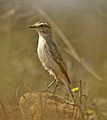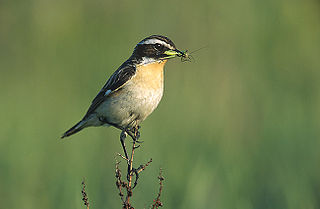
Chats are a group of small Old World insectivorous birds formerly classified as members of the thrush family (Turdidae), but following genetic DNA analysis, are now considered to belong to the Old World flycatcher family (Muscicapidae).

The whinchat is a small migratory passerine bird breeding in Europe and western Asia and wintering in central Africa. At one time considered to be in the thrush family, Turdidae, it is now placed in the Old World flycatcher family, Muscicapidae. Both sexes have a strong supercilium, brownish upper parts mottled darker, a pale throat and breast, a pale buff to whitish belly, and a blackish tail with white bases to the outer tail feathers, but in the breeding season, the male has an orange-buff throat and breast.

The Siberian stonechat or Asian stonechat is a recently validated species of the Old World flycatcher family (Muscicapidae). Like the other thrush-like flycatchers, it was often placed in the Turdidae in the past. It breeds in the East Palearctic including in easternmost Europe and winters in the Old World tropics.

Hume's leaf warbler or Hume's warbler is a small leaf warbler which breeds in the mountains of inner Asia. This warbler is migratory and winters mainly in India.

The pied bush chat is a small passerine bird found ranging from West Asia and Central Asia to the Indian subcontinent and Southeast Asia. About sixteen subspecies are recognized through its wide range with many island forms. It is a familiar bird of countryside and open scrub or grassland where it is found perched at the top of short thorn trees or other shrubs, looking out for insect prey. They pick up insects mainly from the ground, and were, like other chats, placed in the thrush family Turdidae, but are now considered as Old World flycatchers.

Ferdinand Stoliczka was a Moravian palaeontologist who worked in India on paleontology, geology and various aspects of zoology, including ornithology, malacology, and herpetology. He died of high altitude sickness in Murgo during an expedition across the Himalayas.
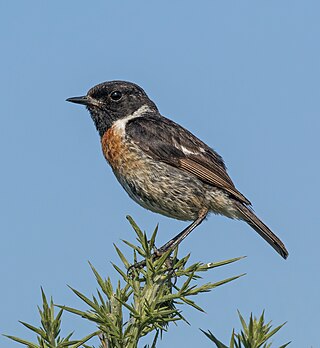
Saxicola, the stonechats or chats, is a genus of 15 species of small passerine birds restricted to the Old World. They are insectivores occurring in open scrubland and grassland with scattered small shrubs.

The African stonechat or common stonechat is a species of the Old World flycatcher family (Muscicapidae), inhabiting sub-Saharan Africa and adjacent regions. Like the other chats, it was long assigned to the thrush family (Turdidae), to which the chats are convergent. Its scientific name refer to its appearance and habitat and means "collared rock-dweller": Saxicola from Latin saxum ("rock") + incola, torquatus, Latin for "collared".

The white-throated bush chat, also known as Hodgson's bushchat, is an Old World flycatcher in the genus Saxicola. It is IUCN Red Listed as Vulnerable by BirdLife International. In 2001, the global population has been estimated at between 3,500 and 15,000 individuals. The major threat appears to be the rapid loss of grasslands in its wintering areas. It winters in the Nepal and Indian Terai and in the Dooars. In this region, it has been recorded in Jim Corbett, Shuklaphanta, Chitwan, Kaziranga, and Manas National Parks and in Lumbini Crane Sanctuary. It prefers wet and dry grasslands, reeds and tamarisks along riverbeds, and also occurs in sugarcane fields. In spring and summer, it breeds in the alpine or sub-alpine meadows and scrub in the mountains of Mongolia and adjacent parts of Russia.

The pale-browed tinamou is a type of tinamou found in tropical dry forests in Peru and Ecuador.
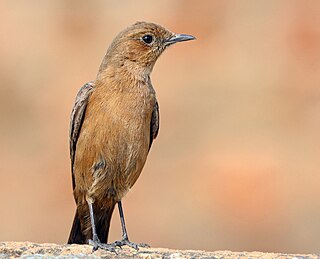
The brown rock chat or Indian chat is a bird species of the family Muscicapidae. It is found mainly in northern and central India. It is often found on old buildings and rocky areas. It resembles a female Indian robin but lacks the reddish vent and differs in posture and behaviour apart from being larger. In flight it bears some resemblance to thrushes and redstarts. It feeds on insects, captured mainly on the ground. It was formerly placed as the sole species in the genus Cercomela but is now included with the wheatears in the genus Oenanthe.

The Karoo chat is a small passerine bird of the Old World flycatcher family Muscicapidae. It is a common resident breeder in southwesternmost Angola, western Namibia and western South Africa. Its habitat is Karoo and desert scrub in the south, extending to the escarpment zone in the north.
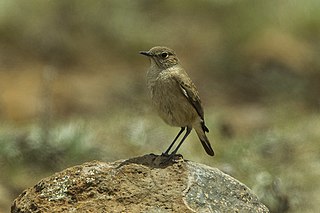
The sickle-winged chat or sicklewing chat is a small passerine bird of the Old World flycatcher family Muscicapidae endemic to southern Africa. It is a common resident breeder in South Africa and Lesotho, and is also found in southernmost areas of Botswana and Namibia. Its habitat is Karoo scrub, short grassland, and barren sandy or stony areas. In western coastal areas, it also occurs on agricultural land.

The white-browed jungle flycatcher, also known as the Luzon jungle-flycatcher and the Rusty-flanked jungle-flycatcher, is a species of bird in the Old World flycatcher family Muscicapidae. It is endemic to Luzon island, in the Philippines. The natural habitat of the white-browed jungle flycatcher is tropical moist montane forests. It is threatened by habitat loss.

The grey bush chat is a species of passerine bird in the family Muscicapidae. It is found in the Himalayas, southern China, Taiwan, Nepal and mainland Southeast Asia.

The white-bellied bush chat is a species of bird in the family Muscicapidae. It is found in Semau, Timor and Rote Island. Its natural habitats are subtropical or tropical moist lowland forests and dry savanna. It is threatened by habitat loss.
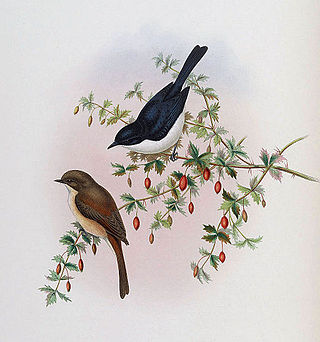
Jerdon's bush chat is a species of bird in the family Muscicapidae.

The white-browed bush robin is a species of bird in the family Muscicapidae. It is found from the Himalayas to south-central China and Taiwan. Its natural habitat is Rhododendron and conifer forests.

Shuklaphanta National Park is a national park in the Terai of the Far-Western Region, Nepal, covering 305 km2 (118 sq mi) of open grasslands, forests, riverbeds and tropical wetlands at an elevation of 174 to 1,386 m. It is bounded by the Mahakali river in the west and south. A small part extends north of the Mahendra Highway to create a wildlife corridor for seasonal migration of wildlife into the Sivalik Hills. It was gazetted in 1976 as Royal Shuklaphanta Wildlife Reserve and was enlarged to its presence size in the late 1980s. A buffer zone of 243.5 km2 (94.0 sq mi) was added in 2004. It receives a mean annual rainfall of 1,579 mm (62.2 in) and harbours 700 floral, 456 bird, 56 reptile and 15 amphibian species.




